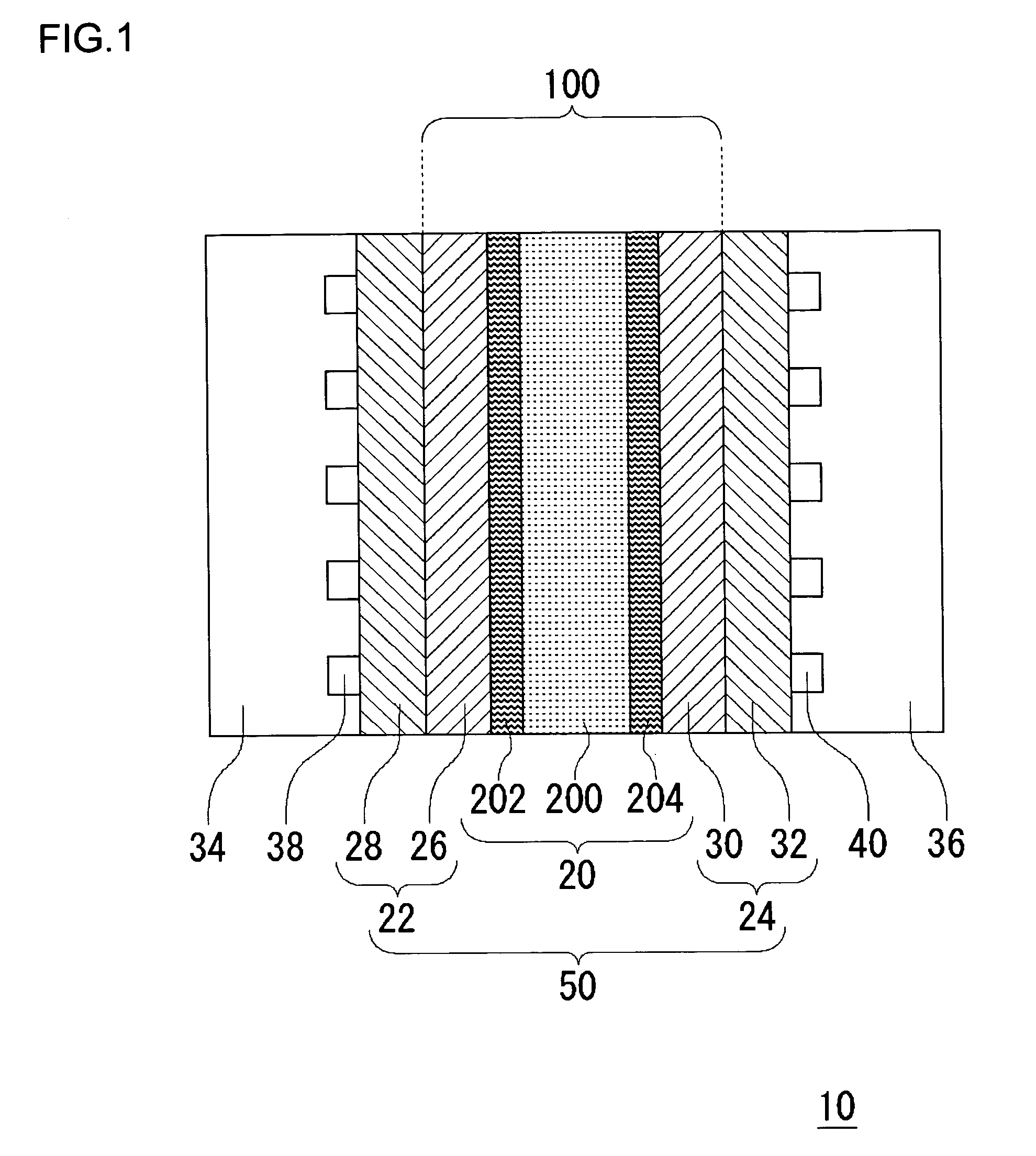Solid polymer electrolyte membrane, solid polymer electrolyte fuel cell using the membrane and method of fabricating the same
a technology electrolyte, which is applied in the direction of non-aqueous electrolytes, conductive materials, chemical/physical processes, etc., can solve the problems of unfavorable structural strength of membrane, and poor assembly of solid polymer electrolyte membrane and catalytic layer, etc., to achieve the effect of improving the ease of handling
- Summary
- Abstract
- Description
- Claims
- Application Information
AI Technical Summary
Benefits of technology
Problems solved by technology
Method used
Image
Examples
first embodiment
(First Embodiment)
[0069]A description will now be given of a construction of a solid polymer electrolyte fuel cell according to the embodiments of the present invention.
[0070]FIG. 1 schematically shows a cross section of a fuel cell 10 according to the embodiments of the present invention. The fuel cell 10 is provided with a sheet cell 50, and a separator 34 and a separator 36 are provided on respective sides of the cell 50. In this example, only one cell 50 is shown. Alternatively, a laminate of a plurality of cells 50 sandwiching the separator 34 and the separator 36 may be provided to construct the fuel cell 10. The cell 50 has a solid polymer electrolyte membrane 20, a fuel electrode 22 and an air electrode 24. The fuel electrode 22 has a laminate of a catalytic layer 26 and a gas diffusion layer 28, and the air electrode 24 similarly has a laminate of a catalytic layer 30 and a gas diffusion layer 32. The catalytic layer 26 of the fuel electrode 22 and the catalytic layer 30 of...
second embodiment
(Second Embodiment)
[0112]In this embodiment, the method of fabricating the electrolyte membrane 100 fitted with catalyst is different from that of the first embodiment. In this embodiment, the fuel cell 10 has a construction similar to that of the first embodiment described by referring to FIGS. 1 and 2. In this and the first embodiment, like components are denoted by like reference symbols and the description thereof is omitted where appropriate.
[0113]FIG. 5 shows a process of fabricating the electrolyte membrane 100 fitted with catalyst according to this embodiment. In a similar configuration as the first embodiment, catalyst ink and fluid dispersion are produced according to this embodiment.
[0114]First, the first solid polymer electrolyte membrane 200 is prepared (FIG. 5(a)). Following this, fluid dispersion is applied to both sides of the first solid polymer electrolyte membrane 200 by brush application, spray application, screen printing, etc. Alternatively, the first solid pol...
third embodiment
(Third Embodiment)
[0120]In this embodiment, the method of fabricating the electrolyte membrane 100 fitted with catalyst is different from that of the first and second embodiments. In this embodiment, the fuel cell 10 has a construction similar to that of the first embodiment described by referring to FIGS. 1 and 2. In this and the first embodiment, like components are denoted by like reference symbols and the description are omitted where appropriate.
[0121]FIG. 7 shows a process of fabricating the electrolyte membrane 100 fitted with catalyst according to this embodiment. In a similar configuration as the first embodiment, fluid dispersion is produced.
[0122]First, the first solid polymer electrolyte membrane 200 is prepared (FIG. 7(a)). Following this, the fluid dispersion is applied to both sides of the first solid polymer electrolyte membrane 200 by brush application, spray application, screen printing, etc, so as to form the second solid polymer electrolyte membranes 202 and 204 ...
PUM
| Property | Measurement | Unit |
|---|---|---|
| temperature | aaaaa | aaaaa |
| thickness | aaaaa | aaaaa |
| thickness | aaaaa | aaaaa |
Abstract
Description
Claims
Application Information
 Login to View More
Login to View More - R&D Engineer
- R&D Manager
- IP Professional
- Industry Leading Data Capabilities
- Powerful AI technology
- Patent DNA Extraction
Browse by: Latest US Patents, China's latest patents, Technical Efficacy Thesaurus, Application Domain, Technology Topic, Popular Technical Reports.
© 2024 PatSnap. All rights reserved.Legal|Privacy policy|Modern Slavery Act Transparency Statement|Sitemap|About US| Contact US: help@patsnap.com










